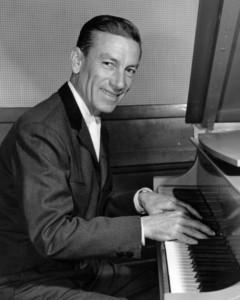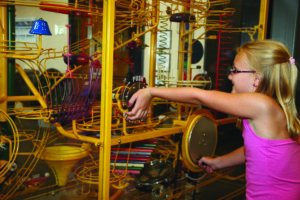It’s easy to get lost in the intricacies of WonderLab’s Kinetic Contraption, otherwise known as a Rube Goldberg machine. WonderLab’s Kinetic Contraption is sponsored by The Brabson Library and Educational Foundation. Located on the first floor of the museum, this is one of the first exhibits visitors see as they enter.
A Rube Goldberg machine takes a very simple task and makes it ingeniously or unnecessarily complicated. For example, Rube Goldberg machines have been created to turn pages in a newspaper or audition for America’s Got Talent. In 2016 a huge Rube Golderberg machine was created to light up a Christmas tree.
In fact, you have very likely seen a Rube Goldberg machine in movies or even your everyday life. For example, a Rube Goldberg machine was built and featured by the group OK Go for their music video for their song “This Too Shall Pass” (2010.) Target used a Rube Goldberg machine in their commercial, “Fresh Machine.” Rube Goldberg machines have been used in popular movies such as “The Goonies” (1985), “Back to the Future” (1985) and “Honey, We Shrunk the Kids” (1989.) Rube Goldberg machines are also used to inspire fun in board games such as Mouse Trap, where players must build a Rube Goldberg machine in order to trap the mouse and win the game. However, after doing a lot of research on Rube Goldberg machines, my personal favorite is called “Goldberg vs. Newton” because of their knowledge of gravity and the interesting science used in building their machine.
How It Works
WonderLab’s Rube Goldberg machine, the Kinetic Contraption, takes a bit of trial and error to accomplish. In order to unlock the secrets of the machine, visitors must push buttons and turn knobs in order to change the direction of the colorful balls.
The machine is roughly the size of a large refrigerator laying on its side. The WonderLab Kinetic Contraption is made up of the following pieces:
- a fire bell
- Xylophone
- vortex
- 57 individual, multi-colored balls
- Big bells
- Little bells
- Long bells
- Circus bells
- tracks
- gears
- Chains
- box music drum
- Weights
- pipe chimes
- cymbals, wheels
- Archimedes Screws
- Links
- Pivots
- timing devices
- v-belt pulleys
- roller chains
- Sprockets
- Magnets
- a scotch yoke
- a circus bell ringer
- multiple axis pendulums
- and more.
The machine stresses the importance of mastering an understanding of the laws of gravity and motion, as well as the cause-and-effect relationship between action and outcome.
Understanding these processes has never been easier than with WonderLab’s machine. The machine is entirely visual and allows you to watch your work in action and problem solve as you predict what will happen to the balls because of your manipulation of the machine.

Our Kinetic Contraption, when manipulated correctly, will play Bloomington local Hoagy Carmichael’s noted American standard “Stardust”, which was composed here on Indiana University’s Campus in 1927.
Stardust
In celebration of Bloomington, the WonderLab Kinetic Contraption plays “Stardust” when sequenced correctly. This song was composed in 1927 by a Bloomington local, Hoagy Carmichael, on the campus of Indiana University.
Originally recorded in Richmond, Indiana, the song has become an American standard and one of the most recorded songs of the 21st century with over 1,500 total recordings, according to National Public Radio. In 2004, Carmichael’s original recording was chosen by the Library of Congress to be added to the National Recording Registry.
With lyrics by Mitchell Parish, this beautiful melody is a love song about a love song and remembering someone who he once loved. Hearing this song after working with the machine is truly a feeling of accomplishment and success. I was fascinated with the inner workings of the machine and after working to hear the machine play this song, I finally heard the familiar tune after a long go at figuring out how I could create music with such a machine.
Who is Rube Goldberg?
Rube Goldberg, born Rueben Garret Lucius Goldberg in 1883, was an inventor, sculptor, author, engineer, cartoonist and Pulitzer Prize-winning journalist. He graduated with a degree in engineering from the University of California, Berkeley. After working as an engineer in San Francisco for a while, he then went on to be a cartoonist for the San Francisco Chronicles then the San Francisco Bulletin. Goldberg married Irma Seeman in 1916 and had two children, Thomas and George.
Goldberg had many cartoon strips including “Doc Wright,” “Lala Palooza,” “The Barodik,” “Mike and Ike – They Look Alike,” “Foolish Questions” and more. After World War II began, Goldberg began to use his cartoon as political satire, but he is most well-known for his engineering illustrations now known as “Rube Goldberg Machines.” He would use his already existing characters from his cartoon strips and create elaborate, complicated devises to do everyday tasks.

Another Goldberg illustration, and likely his most famous work, 1931’s Professor Butt’s and the Self-Operating Napkin.
His first illustrated machine was an Automatic Weight Reducing Machine in 1914, but his most well-known illustration is likely Professor Butt’s and the Self-Operating Napkin in 1931.
Goldberg believed that people desired a more complicated way of thinking, so his machines did the opposite of what other machines were trying to do at the time – rather than making tasks less complicated, his machines made them more complex.
Rube Goldberg Machine Competition
Originally started by two competing fraternities at Purdue University in the 1950s, today there are engineering competitions for the mere purpose of making extreme Rube Goldberg machines and winning prizes for such.
Featuring winning teams from all over the country, each year all the teams are assigned the same simple task to construct their machine. Students of all ages compete against one another to come up with the most creative and complicated machine.
Jimmy Kimmel described Rube Goldberg machines as “an intentionally delightful waste of time” when the 2014 National Rube Goldberg Machine Contest College-level winners appeared on his show.
Make Your Life Just A Little More Complicated
Thanks to pop culture and Youtube, the Rube Goldberg machines have taken on an entirely new face in the public eye. Anyone can attempt a Rube Goldberg machine!
I encourage you to think of your own ways to create a Rube Goldberg machine. I know that I spend a lot of time working to speed processes up, but there is a lot to be learned from slowing them down as well. Spend a rainy day inside and complicate the process to make a sandwich or open a window. Rube Goldberg machines are filled with learning opportunities and can offer an enormous feeling of accomplishment and success after finishing the process and getting your desired outcome.
As Rube Goldberg said, himself, “I do not count the years. Tomorrow is just another day to create something I hope will be worthwhile.”
Meredith Hardy is a former WonderLab Writing and Content Development summer intern and student at Indiana University. She is majoring in Media Advertising and specializing in Public Relations and Sex, Gender and Media. She is also a Music minor and a member of The Singing Hoosiers. Growing up, one of Meredith’s favorite movies was “The Goonies” (1985), and Data’s simple machines were always one of her favorite parts. Come to find out, Data’s machines were Rube Goldberg machines.




Leave A Comment